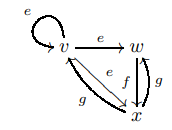| This article may be too technical for most readers to understand. Please help improve it to make it understandable to non-experts, without removing the technical details. (August 2020) (Learn how and when to remove this message) |
In mathematics, an ultragraph C*-algebra is a universal C*-algebra generated by partial isometries on a collection of Hilbert spaces constructed from ultragraphs.. These C*-algebras were created in order to simultaneously generalize the classes of graph C*-algebras and Exel–Laca algebras, giving a unified framework for studying these objects. This is because every graph can be encoded as an ultragraph, and similarly, every infinite graph giving an Exel-Laca algebras can also be encoded as an ultragraph.
Definitions
Ultragraphs
An ultragraph consists of a set of vertices , a set of edges , a source map , and a range map taking values in the power set collection of nonempty subsets of the vertex set. A directed graph is the special case of an ultragraph in which the range of each edge is a singleton, and ultragraphs may be thought of as generalized directed graph in which each edges starts at a single vertex and points to a nonempty subset of vertices.
Example

An easy way to visualize an ultragraph is to consider a directed graph with a set of labelled vertices, where each label corresponds to a subset in the image of an element of the range map. For example, given an ultragraph with vertices and edge labels
,
with source an range maps
can be visualized as the image on the right.
Ultragraph algebras
Given an ultragraph , we define to be the smallest subset of containing the singleton sets , containing the range sets , and closed under intersections, unions, and relative complements. A Cuntz–Krieger -family is a collection of projections together with a collection of partial isometries with mutually orthogonal ranges satisfying
- , , for all ,
- for all ,
- whenever is a vertex that emits a finite number of edges, and
- for all .
The ultragraph C*-algebra is the universal C*-algebra generated by a Cuntz–Krieger -family.
Properties
Every graph C*-algebra is seen to be an ultragraph algebra by simply considering the graph as a special case of an ultragraph, and realizing that is the collection of all finite subsets of and for each . Every Exel–Laca algebras is also an ultragraph C*-algebra: If is an infinite square matrix with index set and entries in , one can define an ultragraph by , , , and . It can be shown that is isomorphic to the Exel–Laca algebra .
Ultragraph C*-algebras are useful tools for studying both graph C*-algebras and Exel–Laca algebras. Among other benefits, modeling an Exel–Laca algebra as ultragraph C*-algebra allows one to use the ultragraph as a tool to study the associated C*-algebras, thereby providing the option to use graph-theoretic techniques, rather than matrix techniques, when studying the Exel–Laca algebra. Ultragraph C*-algebras have been used to show that every simple AF-algebra is isomorphic to either a graph C*-algebra or an Exel–Laca algebra. They have also been used to prove that every AF-algebra with no (nonzero) finite-dimensional quotient is isomorphic to an Exel–Laca algebra.
While the classes of graph C*-algebras, Exel–Laca algebras, and ultragraph C*-algebras each contain C*-algebras not isomorphic to any C*-algebra in the other two classes, the three classes have been shown to coincide up to Morita equivalence.
See also
Notes
- ^ A unified approach to Exel–Laca algebras and C*-algebras associated to graphs, Mark Tomforde, J. Operator Theory 50 (2003), no. 2, 345–368.
- ^ Realization of AF-algebras as graph algebras, Exel–Laca algebras, and ultragraph algebras, Takeshi Katsura, Aidan Sims, and Mark Tomforde, J. Funct. Anal. 257 (2009), no. 5, 1589–1620.
- Graph algebras, Exel–Laca algebras, and ultragraph algebras coincide up to Morita equivalence, Takeshi Katsura, Paul Muhly, Aidan Sims, and Mark Tomforde, J. Reine Angew. Math. 640 (2010), 135–165.
 consists of a set of vertices
consists of a set of vertices  , a set of edges
, a set of edges  , a source map
, a source map  , and a range map
, and a range map  taking values in the
taking values in the  of nonempty subsets of the vertex set. A directed graph is the special case of an ultragraph in which the range of each edge is a singleton, and ultragraphs may be thought of as generalized directed graph in which each edges starts at a single vertex and points to a nonempty subset of vertices.
of nonempty subsets of the vertex set. A directed graph is the special case of an ultragraph in which the range of each edge is a singleton, and ultragraphs may be thought of as generalized directed graph in which each edges starts at a single vertex and points to a nonempty subset of vertices.

 ,
, 

 to be the smallest subset of
to be the smallest subset of  containing the singleton sets
containing the singleton sets  , containing the range sets
, containing the range sets  , and closed under intersections, unions, and relative complements. A Cuntz–Krieger
, and closed under intersections, unions, and relative complements. A Cuntz–Krieger  -family is a collection of projections
-family is a collection of projections  together with a collection of
together with a collection of  with mutually orthogonal ranges satisfying
with mutually orthogonal ranges satisfying
 ,
,  ,
,  for all
for all  ,
, for all
for all  ,
, whenever
whenever  is a vertex that emits a finite number of edges, and
is a vertex that emits a finite number of edges, and for all
for all  is the
is the  for each
for each  is an infinite square matrix with index set
is an infinite square matrix with index set  and entries in
and entries in  , one can define an ultragraph by
, one can define an ultragraph by  ,
,  ,
,  , and
, and  . It can be shown that
. It can be shown that  .
.